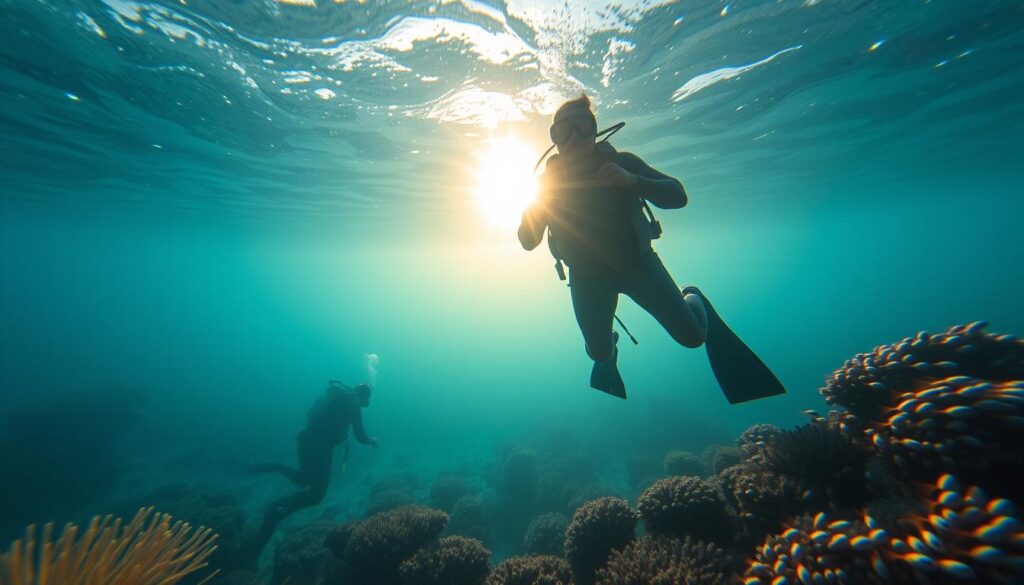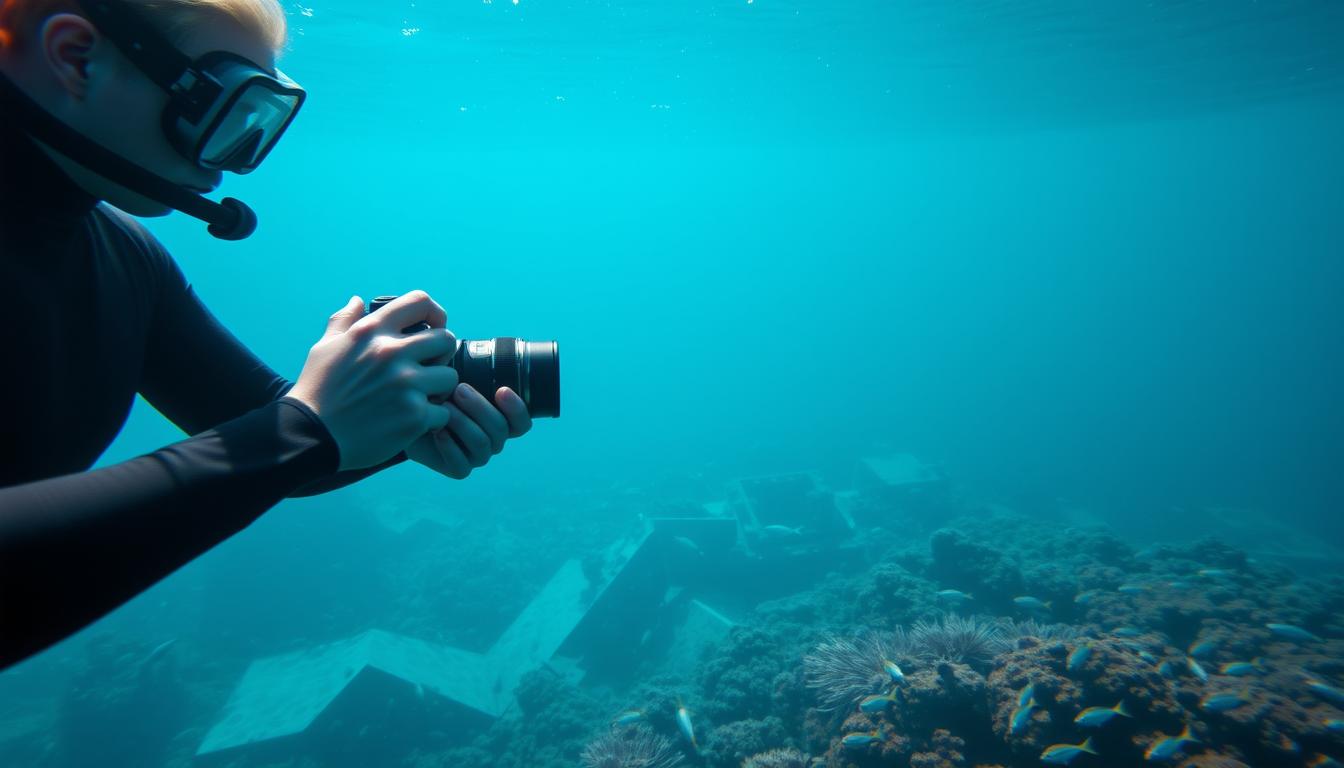Diving into the deep sea world is full of photo chances for eager folks. This underwater photography guide shines a light on the key parts of taking amazing water photos. It’s for beginners and pros wanting to better their skills. Our underwater photography tips and advice will help you in your water picture-taking adventures.
We talk about choosing the best camera and learning important diving skills. Also, we discuss perfecting your technique. Dive into our guide to boost your aquatic photography tips. You’ll be able to catch the colorful, lively beauty of the sea world.
Key Takeaways
- Understand the basics of underwater photography to enhance your skills.
- Learn how to choose the right camera and gear for underwater use.
- Master the importance of lighting for capturing clear, vibrant images.
- Improve your diving skills to get closer to your subjects.
- Utilize manual camera settings for greater control over your shots.
- Explore post-processing techniques to enhance your underwater photos.
- Discover common mistakes and tips on how to avoid them.
Getting Started with Underwater Photography
Underwater photography lets divers show off the ocean’s beauty. It’s important to know a few things to take great photos underwater.
Choosing the Right Camera
Finding the right camera is key for top-notch underwater photos. You can pick from simple cameras to advanced ones. Beginners might like the Olympus Tough TG-6 for its ease and performance. More skilled photographers could go for the Sony Alpha or Canon EOS R series for better control and quality. Make sure your camera is waterproof or has a strong underwater case.
Importance of Lighting
Light matters a lot in underwater photography. Water makes light fade quickly, changing the colors. Underwater photography lighting tips suggest using extra lights or LEDs. They make colors bright and details clear. At low depths, a camera’s flash might work. But for deep water, it’s good to have special lighting.
Basic Diving Skills
Knowing how to dive well is a must before taking underwater photos. It’s all about controlling your buoyancy and being safe. Practicing these skills means you can stay safe and focus on taking photos. A diving course focused on photography can really help.
With the right camera, good lighting, and diving skills, you’re ready to take amazing underwater photos.
Mastering Underwater Photography Techniques
Mastering underwater photography lets you take amazing photos underwater. It means learning special techniques. This helps you make great pictures.
Composition Basics
One key tip is using the Rule of Thirds. Imagine your frame divided into nine parts by lines. Place what you’re taking a picture of along these lines. This makes your photos look good and interesting. Also, try different angles. Taking pictures from below can make your photos stand out.
Manual Settings versus Auto Settings
Choosing manual underwater camera settings is better than auto settings. Manual settings let you control the picture more. This is good for those who know what they’re doing. You can adjust for light and water clarity. This makes your photos clearer and more true to what you see.
Utilizing Natural Light
Using natural light works well in shallow water. It makes your photos bright and clear without fake light. Stand with the sun behind you. This lights up what you’re taking a picture of. It creates beautiful images with light and shadow. Also, learning how light changes underwater helps you take better pictures.
Underwater Photography Tips
To master underwater photography, you need to learn several key techniques. These can make your photos look much clearer and more colorful. By improving your skills, you can take stunning underwater pictures.
Getting Close to Your Subject
Getting close to your subject is super important in underwater photography. Being close lets you avoid the blur that water causes. It also makes the colors and details in your photos pop. Try to be as near as you can to what you’re photographing for the best shots.
Avoiding Backscatter
Backscatter is when light reflects off particles in the water, creating specks in your photos. To fight this, use lights or flashes away from your camera. This trick helps keep the light from hitting particles straight on. Your photos will look clearer as a result.
Post-Processing Tips
Editing your underwater photos is super important. Good editing can make your photos look even better. Use programs like Adobe Lightroom or Photoshop. With them, you can fix colors, add contrast, and clean up any remaining specks. Spending time on editing will really make your underwater photos stand out.
| Challenge | Solution |
|---|---|
| Water Distortion | Get Closer to Subject |
| Backscatter | Use External Strobes |
| Color Correction | Post-Processing |
Optimal Camera Settings for Underwater Photography
Having the right camera settings is key to great underwater photos. The right settings help capture the beauty of sea life and places below the water. This ensures your pictures will be bright, clear, and full of color.
Resolution and ISO Settings
Start by using a high resolution. This lets you see tiny details and edit photos better later. Keep the ISO low, like 100 or 200, to avoid grainy images.
Low ISO keeps photos sharp and clear. For extra tips on settings adjustments, check out this detailed guide on underwater camera settings.
White Balance Adjustments
Adjusting white balance is important underwater. It helps fix the blue color that water adds to photos. A custom setting works best for true color.
Learning about white balance can make your photos look better. It brings out real colors in your underwater shots.
Shutter Speed Considerations
Choosing the right shutter speed matters. It captures moving scenes well or shows smooth motion in low light. For close-ups, use faster speeds like 1/1000th. For wide shots, 1/100th can work well.
Digging into shutter speed can really improve your underwater photos. Try different speeds to see what looks best in your adventures.
Essential Underwater Photography Gear
Taking amazing photos underwater needs skill and the right gear. Important are camera housings and lights.
Camera Housings
Camera housings keep your gear safe underwater. They come in different types, from basic to advanced. Choosing the right one keeps your gear safe and photos sharp.
External Strobes and Lights
Good lighting is key for stunning underwater photos. Without it, photos can look blurry and dull. With the right lights, your photos will be bright and colorful.
Improving Your Underwater Photography Composition
Improving how you compose underwater photos can make them much more powerful. Following basic rules can help you take amazing and creative underwater photos.
Rule of Thirds
The Rule of Thirds is a top tip for better underwater photos. It improves the look of your photos by breaking the frame into nine parts. You place the subject along these lines or where they meet. This rule makes your photos balanced and more interesting. It changes normal pictures into fantastic underwater scenes. For more details, check this guide.

Shooting at Upward Angles
Shooting from low angles makes your photos look special. It adds depth and makes things look bigger. Be below your subject and shoot up. This shows a cool mix of light and water, making your photo stand out.
Focusing on the Eyes
Focusing on eyes is key in underwater photography, especially for pictures of sea life. Eyes are important in every portrait. Making them sharp creates a bond between the viewer and the photo. This method brings your pictures to life, catching the audience’s attention. Good focusing makes your photos look real and interesting.
Advanced Underwater Photography Practices
Mastering underwater photography means making your setup and style better. You have to adjust for water’s tricks and use light well. This makes your photos clearer and better.
Dieters for Different Lenses
Diopters are very important for underwater photos. They help fight the water’s bending of light, so your shots are sharp. Diopters let you get close to things underwater without losing detail.
This is key for clear, detailed underwater photos. Knowing which diopter fits your lens helps a lot. It makes your pictures a lot better.
Using External Lights Effectively
External lights are a big deal underwater. They help you light your subjects well and fight backscatter. Use strobes or lights from a good angle to keep the water clear.
Keep practicing to get your lighting just right. This brings out the colors and makes everything look better. Your underwater pictures will really pop.
Common Mistakes in Underwater Photography and How to Avoid Them
One big mistake in underwater photography is not having a clear focus. This can really lower the quality of the photo. Make sure what you’re shooting is sharp and clear. You can use the camera’s autofocus or adjust it by hand to fix this issue.
Using the wrong exposure settings is another mistake. You need to balance the aperture, shutter speed, and ISO. This lets you take good photos under the water, no matter the light. Try different settings to see how they change your photos.
Compositional mistakes can also mess up good photos. Use rules like the rule of thirds, fill your frame, or use lines to lead the eye. Learning and using these tips can help you avoid these common errors.
Conclusion
This guide showed you how to take amazing photos underwater. It talked about the right gear and how to use light. It also explained the best ways to take pictures and set up your camera.
To get good at underwater photography, keep trying and learning. Make sure to dodge common mistakes. Follow these tips to take better photos. Pay attention to how you set your camera. Use lights the right way. And remember, underwater photography has its own challenges.
Getting better at taking photos under the water is a mix of skill and creativity. Use what you’ve learned here every time you dive. Explore new places under the water. Let your love for photography grow. This will make you an even better photographer.
